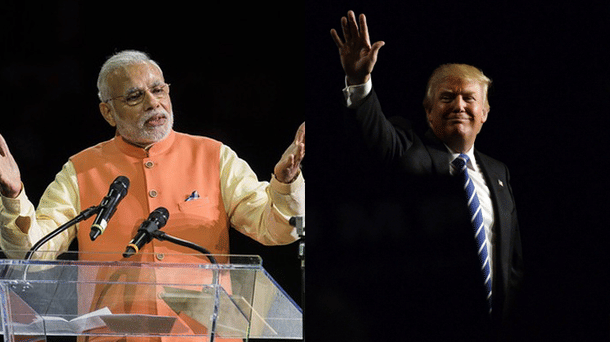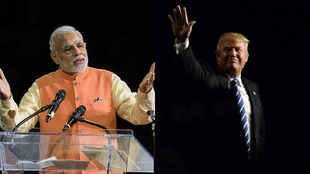Politics
Chalk Vs Cheese: Why The Modi-Trump Comparison Made No Sense, And Now Even Less So
R Jagannathan
May 18, 2017, 02:42 PM | Updated 02:42 PM IST
Save & read from anywhere!
Bookmark stories for easy access on any device or the Swarajya app.


It is interesting to contrast Donald Trump’s performance in the US, and Narendra Modi’s in India, given that many people put both of them in the same category of outsiders, who challenged the establishment to come to power. The analogy was and is wrong, for Modi was always a gifted politician, while Trump does not seem to have the ability to say anything coherent beyond what Twitter can handle. The Modi-Trump comparison is worth debunking.
In terms of outcomes, less than six months after inauguration, Trump is facing the possibility of impeachment, with his former National Security Advisor Michael Flynn being linked to Russia. Proving his novice status as administrator, Trump fired Federal Bureau of Investigation Director James Comey, only to be accused himself of leaking some state secrets to the Russian foreign minister. Given a Republican majority in both houses of Congress, Trump is unlikely to be impeached, but his reputation will certainly be dragged into mud, thanks to a biased and hostile ‘liberal’ media.
Modi faced the same hostile media, but he managed to make it irrelevant. At the end of six to seven months in office, he had led his party to four major electoral gains in Haryana, Jharkhand, Maharashtra and Jammu & Kashmir. His only misstep was the decision to issue lots of ordinances towards end-2014, including one on land acquisition, a rash move given the opposition majority in the Rajya Sabha. But he has since avoided mistakes of this kind, including political ones after defeats in Delhi and Bihar.
Lesson 1 for those who put Modi and Trump in the same bucket: Modi learns from his reverses, Trump is refusing to do so, and is instead making things worse for himself by repeatedly targeting the media. He is compounding his mistakes. In India, Modi made the mainstream media irrelevant by letting it stew in its own juice of half-truths, thus discrediting itself, as it did with the fake “church attacks” nonsense.
Now let us consider why comparing Modi to Trump is like comparing chalk to cheese despite outward similarities.
#1: Both Modi and Trump challenged their own parties, and built their victories by talking over the heads of party bosses directly to voters. But Modi complemented this by building a coalition of allies across states, and adopting a coherent slogan sabka saath, sabka vikas that was positive. Trump’s message was wholly negative: he would throw out illegal immigrants, build a wall, renegotiate unfair treaties, and protect American jobs. Worse, he alienated potential allies, from Europe to Japan, by alleging they were living off American largesse.
Modi overcame his image in 2014, while Trump is being sunk by his reputation. Despite his Gujarat reputation as a Hindutva icon, Modi threw a challenge to both Hindus and Muslims after the Patna election rally blasts that is worth noting: he said Hindus and Muslims could fight each other, or fight poverty and illiteracy jointly. Despite some strong rhetoric, Modi sought to reduce the communal divide, while Trump made the divisions in his society sharper.
#2: Trump failed to see that once in government, you are the insider, and your rivals the outsiders. This means making peace with the bureaucracy, and making changes quietly.
Modi did the exact opposite. While he did bring a few babus of his choice, both from his larger eco-system and from the people who served him well in Gujarat, he did not mess with the bureaucracy. Changes were few and far between, and despite imposing discipline in terms of office attendance and faster file movements, he did not try to make the babu his enemy. This is why he is getting more done – as was the case with the Atal Behari Vajpayee government.
In Trump’s case, he is under siege in his own government. No less a supporter than Jack Welch, former chief executive officer of GE, has blasted Trump for his poor “messaging and communications” and gave him “an overall D-minus when it comes to managing the federal bureaucracy.” He told CNBC: “I think without question we’ve got a guy that’s on the right agenda with crappy management practices.”
In the case of Modi, it is the opposite. You may or may not agree with his agenda, but his execution and communication on the agenda are flawless.
#3: Neither Modi nor Trump is an economic ideologue; as a Republican President, Trump is not a born-again Christian, nor a believer in free markets, though he does talk of lower taxes and regulations. Modi believes in ease of doing business, but he is not doctrinaire in his economic beliefs: he does not necessarily believe in a small state, nor in privatising businesses even though he has said that the government has no business to be in business.
Trump gets little cooperation in Congress, as he often upsets his own partymen.
In office, Modi has managed to get opposition cooperation when it matters – as in the case of the goods and services tax (GST), the bankruptcy code, the coal and insurance legislation, etc. But he uses changes in rules to get things done, and gaps in the law to get legislation passed. Thus, subsidy reform has been attempted through direct benefit transfers, and the Aadhaar bill was passed by calling it a money bill that does not need the Rajya Sabha’s nod.
Trump has not been canny enough to understand how he can make his agenda work by using the system, and tweaking it smartly using his presidential powers. The powers of the US President are enormous, but Trump has managed to circumscribe himself with his impulsiveness; the Indian system of parliamentary democracy is more cumbersome, but Modi has managed to make the system effectively presidential, using the Prime Minister’s Office as the driver of change.
#4: Trump’s anti-women biases and frequent marriages made him a hate object with women’s groups; Modi’s singleton status, despite having been married and having left his wife to carry on alone, is accepted in India. By not talking about it, he has allowed the Indian admiration for brahmacharya to be seen as a deep dedication to duty.
#5: Modi believes in moulding public perceptions by orchestrating carefully-thought-out programmes and issues. Trump seems to do things with his gut-instinct and a fair degree of impulsiveness and rashness. Modi is more strategic in letting people know what he thinks or feels on any issue. There is nothing unplanned or impulsive about what he says. He has been more successful in managing perceptions, even though his enemies refuse to change their minds about him. Trump, on the other hand, has managed to make enemies out of allies by his cantankerous talk and behaviour.
#6: Trump has allowed the Deep State in America – the media establishment, the investigative and surveillance agencies – to outmanoeuvre him. Thus, even though friendship with Russia is vital to defeating Islamic State and other violent jihadi groups, US policy is now decidedly anti-Russia despite earlier Trump rhetoric.
In India, Modi has managed to sideline the Deep State, including the media establishment, and both the opposition-ruled states and the judiciary are now working with the Centre to maintain a balance of powers. The bureaucracy may not be fully happy with Modi as boss, but it is not alienated either. Some bright sparks in his cabinet and the bureaucracy see Modi as their route to achievement and advancement.
#7: Modi has no place for cronies in his government, nor has he displayed any love for special favours to businessmen, despite his alleged closeness to “Ambani and Adani”. Neither of them is now in any position to influence policies, which are made, rightly or wrongly, for the nation.
Trump, having started as a businessman and with close business relationships, has never been able to shed his crony status. Nor has he enhanced his image by putting family members in office in the White House.
#8: Trump has backed off repeatedly from his rhetoric of putting China in its place. Modi, on the other hand, despite extending a hand of friendship to both China and Pakistan, is putting in place policies to counter China, including on the latest issue of participating in China’s hegemonic One-Belt-One-Road initiative. India has opted out, and will build its own regional infrastructure with neighbours. Both Trump and Modi will find themselves isolated (Trump from his European allies and trade partners and Modi in the context of the China-Pakistan security nexus in South Asia), but Modi’s policy is one induced by Chinese hegemonic intentions, while Trump’s isolation is largely self-inflicted due to his election rhetoric.
#9: The biggest difference between Trump and Modi is their personal commitment to what they believe in. Modi is willing to put in 18-hour days and a punishing election schedule to drum up support for his policies, right or wrong, GST or demonetisation. Trump does not seem to have energies of this kind, or to go for explanations that exceed 140 characters. He can make longer rash statements, but his logic stalls after a few sentences – as this interview to The Economist shows.
The bottomline is simple: Trump’s rhetoric was driven by negativity and unrelated to his real strengths. Modi’s communications are positive, and backed by a steely resolve to be one of India’s big achievers.
What truly divides Modi from Trump is this strong separating line between words and deeds.
Jagannathan is former Editorial Director, Swarajya. He tweets at @TheJaggi.




